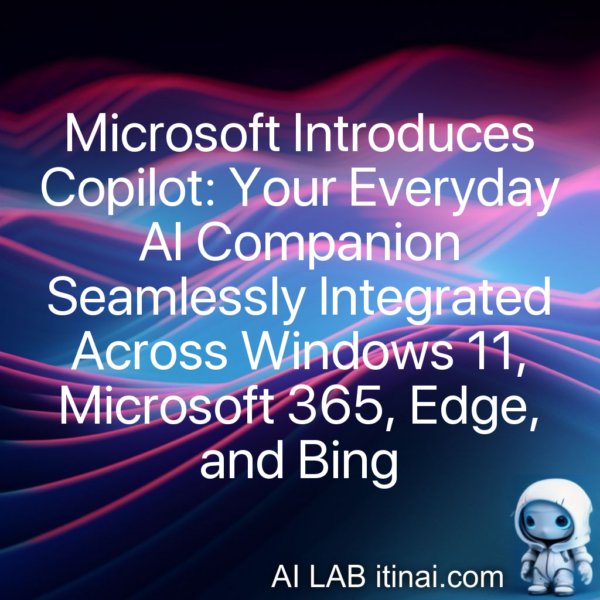Microsoft has introduced Copilot, an AI assistant integrated across Windows 11, Microsoft 365, Edge, and Bing. It aims to provide support while maintaining privacy and security, using web context and intelligence with user data. Copilot offers a unified experience and is available as a free update to Windows 11. Pricing varies depending on the program it is added to. Microsoft plans to expand Copilot’s features, integrate it with other apps, and gather user feedback for improvements. Action items include expanding features, conducting research, releasing previews, exploring integrations, enhancing user experience, ensuring privacy and security, providing training and support, offering different pricing options, launching the enterprise version, and marketing and promoting Copilot.

– Microsoft has introduced Copilot, an AI assistant that is integrated across Windows 11, Microsoft 365, Edge, and Bing.
– Copilot aims to provide support while maintaining privacy and security.
– It incorporates web context and intelligence with user data to deliver superior assistance.
– Copilot offers a unified experience across devices and platforms and is available as part of a free update to Windows 11.
– The pricing for Copilot varies depending on the program it is added to.
– Microsoft researchers have integrated AI-powered guides into popular products like GitHub, Microsoft 365, Bing, Edge, and Windows.
– Copilot uses the web’s context and intelligence along with user data to provide support without compromising privacy or security.
– It can be accessed through apps or with a right-click.
– Microsoft plans to expand Copilot’s features and integrate it with other commonly used apps.
– Release previews of Copilot for Bing, Edge, and Microsoft 365 are available as part of the free update to Windows 11.
– Microsoft showcased new experiences and gadgets to enhance productivity and creativity.
– Copilot is Microsoft’s AI assistant that works with Microsoft 365, Windows 11, Edge, and Bing.
– It provides AI-powered help throughout various Microsoft programs.
– It includes a chat feature called Microsoft 365 Chat, which can answer inquiries and assist with tasks using information from Microsoft Office programs.
– Bing and Edge now allow users to search for products faster and provide more specific suggestions.
– Microsoft Edge customers have received over $4 billion in discounts in the past year.
– Copilot’s pricing ranges from free to thousands of dollars, depending on the program it is added to.
– Enterprise users can purchase Microsoft 365 Copilot for $30 per user per month starting from November 1.
– Copilot improves productivity, reduces mental stress, and simplifies complex problems.
– It is easily accessible through the taskbar or a keyboard shortcut.
– Microsoft is focused on expanding Copilot’s capabilities, ensuring privacy and security, and providing a unified experience across devices and platforms.
– They also plan to offer training and support for users and gather feedback to make necessary improvements.
Based on the meeting notes, here are the action items and their assigned teams:
1. Expand Copilot’s current set of features and establish deeper integrations with the most commonly used apps. – Assigned to the development team.
2. Conduct research and development to further improve Copilot’s capabilities. – Assigned to the research team.
3. Release previews of Copilot for Bing, Edge, and Microsoft 365 as part of the free update to Windows 11. – Assigned to the release team.
4. Explore the possibility of integrating Copilot with other Microsoft programs, such as Word, Outlook, Excel, PowerPoint, and Teams. – Assigned to the integration team.
5. Enhance the user experience by incorporating the web’s context and intelligence alongside work data and information about user activities on their computer. – Assigned to the user experience team.
6. Ensure privacy and security while delivering superior support through Copilot. – Assigned to the security team.
7. Offer a unified experience across devices and platforms. – Assigned to the compatibility team.
8. Provide training and support for users to effectively utilize Copilot’s features. – Assigned to the support team.
9. Offer different pricing options for Copilot based on the program it is being added to. – Assigned to the pricing team.
10. Launch the enterprise version of Microsoft 365 Copilot on November 1 for a price of $30 per user per month. – Assigned to the sales team.
11. Promote Copilot as a tool that increases productivity, reduces mental stress, and simplifies complex problems. – Assigned to the marketing team.
12. Develop marketing strategies to promote Copilot to potential users. – Assigned to the marketing team.
13. Monitor customer feedback and make necessary improvements to Copilot based on user experiences. – Assigned to the customer feedback team.
Please let me know if there are any additional action items or if any clarification is needed.
List of Useful Links:
- AI Scrum Bot – ask about AI scrum and agile
- Microsoft Introduces Copilot: Your Everyday AI Companion Seamlessly Integrated Across Windows 11, Microsoft 365, Edge, and Bing
- ITinAI.com
- Twitter – @itinaicom
























